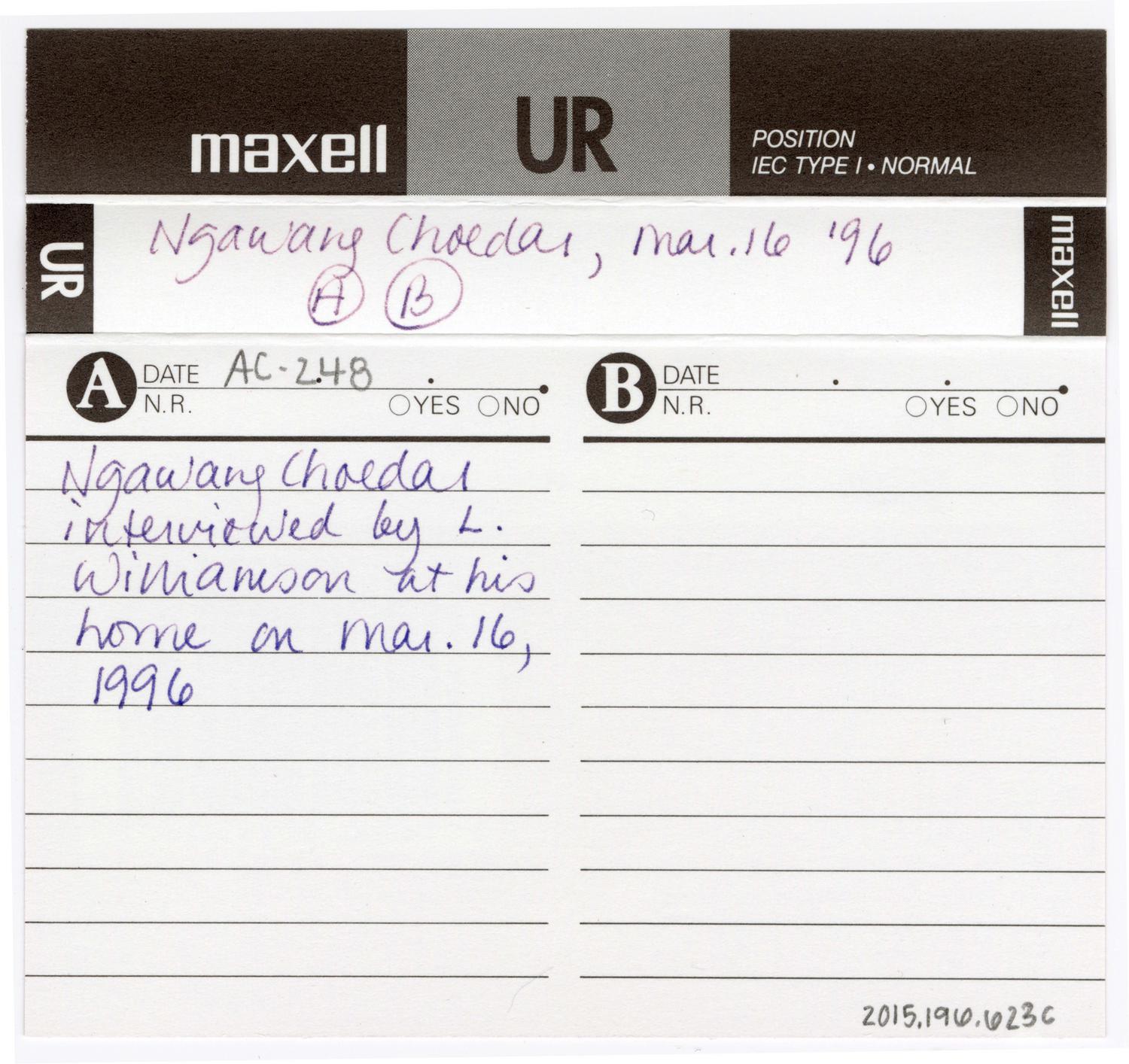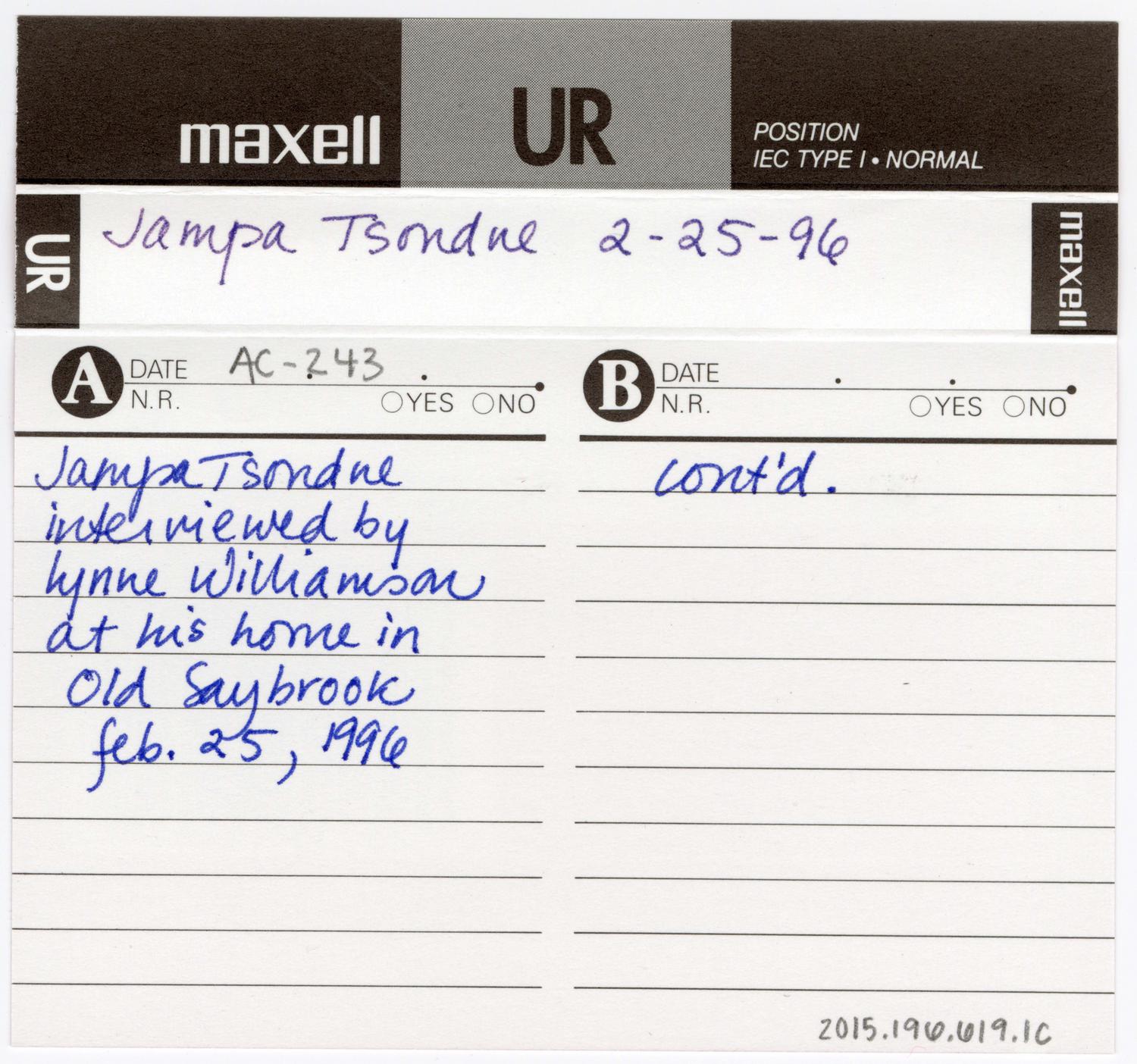Interview with Ngawang Choedar
IntervieweeInterview with
Ngawang Choedar
(Tibetan)
InterviewerInterviewed by
Lynne Williamson
Date1996 March 16
Mediumreformatted digital files from audio cassette tape - MP3
DimensionsDuration (side 1): 47 Minutes, 28 Seconds
Duration (side 2): 44 Minutes, 8 Seconds
Duration (total runtime): 1 Hours, 31 Minutes, 45 Seconds
ClassificationsInformation Artifacts
Credit LineConnecticut Cultural Heritage Arts Program collections
CopyrightIn Copyright
Object number2015.196.623a-d
DescriptionAudio cassette tape recording of an interview with Ngawang Choedar, a Tibetan woodcarver and artist, interviewed by Lynne Williamson at his home in West Haven, Connecticut on March 16, 1996. The interview was recorded as part of the 1996-1997 exhibition project, "Auspicious Signs: Tibetan Arts in New England."
NotesBiographical Note: Twenty-seven years old at the time of the Auspicious Signs project, Ngawang Choedar showed a remarkable skill in woodcarving. His father was a well-known Tibetan woodcarver and traditional architect from near Lhasa, who fled Tibet for Dharmasala, India. Ngawang inherited his father's love for wood, further developing his carving knowledge at the Tibetan Library in Dharmsala where he apprenticed for four years. Ngawang's teacher there was a monk from Kham in Tibet who both taught students and supervised them in making elaborate carved tables commissioned by monasteries in India and Japan. They also carved a wooden altar for the Dalai Lama. It could take as long as a year to finish a large table with several decorated panels carved with traditional Tibetan designs such as Buddhist symbols, mythological animals, and landscape scenes. Ngawang brought his woodworking tools with him to Connecticut in 1992. He found a job in West Haven making specialized countertops, learning new techniques of industrial woodworking. The more delicate art of traditional Tibetan carving, as he learned it, is difficult to do in a small apartment even though Ngawang uses only his saw, whetstone, chisels, and the flat arm of a chair to create intricate, almost molded three-dimensional carved forms. Usually he carves pieces out of a soft pine called chil, easier to work than the hardwoods for furniture which require hammer and chisel.
After tracing designs (he uses many from his father) onto a flat piece of wood, Ngawang holds the wood with one hand while cutting shapes with his bamboo fret saw. This seemingly simple tool is ingenious and flexible, as it allows him to cut curved lines into tightly spaced shapes. By unstringing the serrated wire, threading it through a pierced hole in the center of the wood, then rewiring the saw, Ngawang can shape the middle of the wood block without cutting into it from the edge. Once the shapes are cut, depth and detail are added with a variety of gouges and chisels. To make a piece such as a large frame or table, individual panels or sections are carved, then assembled.
"The place I was born is near Mt. Everest. You can't see a lot of trees, you can't see lights, you can't see cars, you can't see anything! It's six or seven days walking through Nepal to the place I was born...my father built a monastery in that place. My dad and my teacher, they're the only ones who can draw the designs freehand and just carve it...that's why we need to keep all those designs they carved - write them down (copy them)...they learned all those designs in their lives and they are great."
Subject Note: "Auspicious Signs: Tibetan Arts in New England" was an exhibit project developed by the Connecticut Cultural Heritage Arts Program (CCHAP) at the Institute for Community Research in Hartford in 1996. The exhibit opening and a festival of Tibetan arts and music served as the major public events of an eighteen-month research and programming project conducted by CCHAP in partnership with the Tibetans. The project celebrated the Tibetan community's preservation and practice of their traditions in America.
Since the Tibetan Resettlement Project brought twenty-one Tibetans to live in Connecticut, the state has become home to one of the fastest growing Tibetan communities in the United States. Several Connecticut Tibetans are traditional artists of great skill who are deeply committed to expressing and passing on Tibetan culture. Members of the Tibetan community are also dedicated to educating others about the difficult history and circumstances of the Chinese occupation of Tibet.
The collaborative project team consisted of three Tibetan project assistants, exhibit designer Sarah Buie, the Tibetan Cultural Center of Connecticut, artist Sonam Lama who was at the time Vice President of the Massachusetts Tibetan Association, and curator/folklorist Lynne Williamson, then director of CCHAP. The interdisciplinary nature of the team served to broaden the project's outreach to regional Tibetan communities as well as to incorporate a rich variety of expertise and perspectives.
The project team produced an exhibit displaying Tibetan religious art as well as everyday traditional arts, a day-long festival featuring artists, performers, demonstrations, and discussions, and an illustrated catalogue. Artists Jampa Tsondue, Ngawang Choedar, and Tsering Yangzom were featured in a video documenting their artistic process.
Funders included the Lila Wallace Readers Digest Community Folklife Program administered by the Fund for Folk Culture and underwritten by the Lila Wallace-Reader's Digest Fund; the National Endowment for the Arts Folk and Traditional Arts Program, the Connecticut Commission on the Arts, the Connecticut Humanities Council and the Institute for Community Research.
To mark the exhibit opening, the Tibetan community held a festival attended by over three hundred people, including Tibetans from all over the region. Four music and dance groups performed outside, while in the exhibit gallery three Tibetan artists demonstrated weaving, woodcarving, and thangka painting. The event also featured a bazaar, a common Tibetan cultural activity. Many Tibetans are keen traders, maintaining links to Dharamsala, India, and Nepal through import of goods to the U.S. and sale through small shops here. Six Tibetan vendors from all over the region set up tables during the festival with a great variety of Tibetan books and crafts. Lakedhen and five other community members had risen at dawn to prepare food, which they sold during the day. Several speakers described the background of the project, the story of the Connecticut community, the current political situation in Tibet, and the history and character of Tibetan culture. Cholsum dance group from New York City and musicians Lakedhen and Thupten performed and accompanied the dancers. Singer Dadon and her group played for over an hour.
Additional audio, video, and/or photographic materials exist in the archive relating to this community and artist.
Cataloging Note: This project was made possible in part by the Institute of Museum and Library Services MA-245929-OMS-20.
Status
Not on viewDadon Dawa Dolma
1995 June 23












